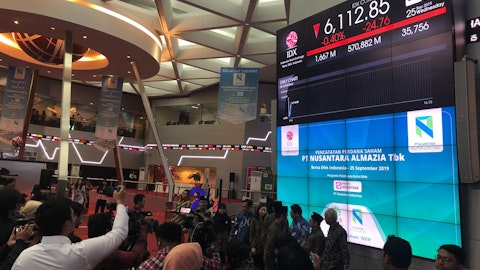PagSeguro Digital Ltd. (NYSE:PAGS) Q2 2023 Earnings Call Transcript August 24, 2023
PagSeguro Digital Ltd. beats earnings expectations. Reported EPS is $1.28, expectations were $0.25.
Operator: Good evening. My name is Kyle and I’ll be your conference operator today. Welcome to PagSeguro Digital Earnings Conference Call for the Second Quarter of 2023. [Operator Instructions] This event is also being broadcast live via webcast and may be accessed through PagBank website at investors.pagseguro.com. Participants may view the slides in any order they wish. Today’s conference is being recorded and will be available after the event is concluded. I would now like to turn the call over to your host, Eric Oliveira, Head of IR. Please go ahead.
Eric Oliveira: Hello, everyone. Thanks for joining our second quarter 2023 earnings results call. After the speakers’ remarks, there will be a question-and-answer session. Before proceeding, let me mention that any forward-looking statements included in the presentation or mentioned on this conference call are based on currently available information and PagSeguro Digital’s current assumptions, expectations, and projections about future events. While PagSeguro Digital believes that the assumptions, expectations, and projections are reasonable in view of currently available information, you are cautioned not to place undue reliance on these forward-looking statements. Actual results may differ materially from those included in PagSeguro Digital’s earnings presentation or discussed on this conference call, for a variety of reasons, including those described in the forward-looking statements and risk factor sections of PagSeguro Digital’s most recent Annual Report on Form 20-F and other filings with the Securities and Exchange Commission, which are available on PagSeguro Digital’s investor relations website at investors.pagbank.com.

Finally, I would like to remind you that during this conference call, the company may discuss some non-GAAP measures, including those disclosed in the presentation. We present non-GAAP measures when we believe that the additional information is useful and meaningful to investors. The presentation of this non-GAAP financial information, which is not prepared under any comprehensive set of accounting rules or principles, is not intended to be considered separately from, or as a substitute for, our financial information prepared and presented in accordance with IFRS as issued by the IASB. For more details, the foregoing non-GAAP measures, and the reconciliation of these non-GAAP financial measures to the most directly comparable IFRS measures, are presented in the last page of this webcast presentation and earnings release.
With that, let me turn the call over to Ricardo. Thank you.
Ricardo Dutra: Hello, everyone, and thanks for joining our second quarter 2023 earnings call. Tonight, I have the company of Alexandre Magnani, our CEO; Artur Schunck, our CFO; and Eric Oliveira, Head of IR. Before Alexandre and Artur share the main highlights for the quarter, I would like to share the most recent milestones in the first half of 2023. Going to Slide 3, we ended June with 29.5 million clients, which along the past years, found in our comprehensive set of payments in Financial Services Solutions. The opportunity experienced a simple, safe, seamless and digital way to manage their financial lives. By using our POS devices, our online and cross-border payment platforms or proprietary set of softwares in our digital bank, we were able to surpass more than BRL2 trillion in volumes processes.
Interesting to point out that it took 16 years for the company to surpass the first BRL1 trillion in volumes and all in one year to surpass the [second] trillion. At the same time, we have maintained our consistent and disciplined throughout several scenarios such as pandemic, interest rate cycles and changes in the competitive and regulatory landscape. Still, our strategy to combine growth with profitability since day one, led to our solid financial position of BRL7.6 billion in accumulated net income and more than BRL10 billion in net cash balance. We kicked off August with S&P Global attributing the highest rating in the local scale brAAA to BancoSeguro, our subsidiary responsible for the issuance of PagBank certificate of deposits, one of our competitive strengths in our funding strategy.
I would like to take advances to reinforce our commitment to our mission to make easier the financial lives of Brazilians by offering a one-stop shop solution through one app, one Internet banking and one customer care center. Now I pass the word over to Alex for the commentaries on the second quarter 2023 highlights. Thank you.
Alexandre Magnani: Thank you, Ricardo. Hello, everyone. I would like to present how the growth, profits and cash generation drivers behaved during the second quarter of 2023. Our earnings per share market BRL1.18, 7% higher year-over-year. Our strategy to grow in selected verticals resulted in higher margins with adjusted EBITDA reaching BRL849 million, 90 basis points higher than the second quarter of 2022, resulting in net income of BRL415 million in non-GAAP basis. Our cash earnings grew 24% year-over-year and our capital expenditures was 8% lower than the second quarter of 2022. Our one-stop shop solution has been consistently attracting more and more clients’ engagement. Total payment volume from our Payments division reached BRL92.7 billion and PagBank cash-in of BRL50 billion driving up deposits on platform.
In Financial Services division, the highlight was the sustain at breakeven point despite the expected impact related to the regulatory change on prepaid and debit cards in Brazil. Adjusted EBITDA improved BRL66 million versus the second quarter of 2022. In Payments division, our strategy for the last 12 months was to focus on key segments that kept us on track. MSMB TPV grew 10%, almost twice as much as the industry growth this quarter. Our merchant acquiring business remains solid and through the combination of our superior value proposition and the broad reach of our sales channels. We have been able to grow above the market in the MSMB segment as presented in Slide 5. During the first 45 days of 3Q ’23, we noticed an uptrend in TPV growth to 8.5% year-over-year from 4% on the second Q ’23.
In MSMB, we have improved our sales on the online channel, which we expect to contribute to the TPV growth moving forward. HUBs presented further improvements in sales productivity and increased cross-selling of financial service through PagBank business account. This not only allows merchants to have access to our instant prepayment product, but also settle direct deposits from different acquirers into PagBank in the case where merchants adopt more than one acquirer. This has been driving up accounts balanced deposits and improving our understanding about merchants needs resulting higher share of wallet. As a result, our consolidated TPV per merchant went up 15% year-over-year. In large accounts, our developments in online and cross-border have been evolving, increasing our footprint in Latin American countries, expanding our set of features and fostering the omni channel offerings.
Through our strategy of diversifying our merchants base focusing on key segments, we expect to drive incremental volumes and gross profit contribution in the future. Moving to Slide 6, we present our client base and cash-in evolution. Our number of PagBank clients reached almost BRL30 million placing us among the most relevant Brazilian financial institutions. From now on, we will pivot our focus on activation and principality rather than number of clients stimulate higher usage and revenue growth for client. Our BRL93 billion in TPV and BRL50 billion in PagBank cash-in led deposits on platform up 25% compared to the second quarter of 2022. This represents 86% of our total deposits and kept our annual percentage yields at 94% of the CDI. We expect further growth in our deposits in the next months, which may be boosted by our AAA rating attribute by S&P Global, which will enhance our CDs distribution among the institutional and retail investors on and off platform.
Slide 7 shows that our outstanding credit portfolio reached BRL2.8 billion with 52% being composed by secured products such as payroll loans and credit cards. The ongoing downtrend in NPLs over 90 days to 14.4% combined to our tax planning allowed us to write off BRL219 million. This amount is already fully provisioned in previous quarters with no impact in P&L. At the same time, we continue to grow our payroll book loan, which is focused on the public sector employees and retirees. This opportunity remains extremely attractive to us as our development to provide end-to-end digital underwriting allow us to give very competitive price with incremental gross profit contribution, which will continue to open new growth avenues. Now I turn over to Artur for the financial highlights of the second quarter 2023.
Artur please?
Artur Schunck: Thanks, Alexandre. Hello, everyone, and thank you for joining us tonight. Once again, PAGS presented another set of records for a second quarter in the company’s history. TPV, gross profit, net income and cash earnings market all-time high figures. Total revenue and income grew 2% quarter-over-quarter, positively impacted by TPV growth and financial income, partially offsetting the impacts in top line related to the regulatory change in interchange cap on prepaid and debit cards that came in force in April 1. Our winning funding strategy has led down for the third consecutive quarter, the financial expenses despite no change in Brazilian interest rate in the second quarter 2023. Our additional leverage coming from lower losses and operating expenses led to EBITDA growth of 8% quarter-over-quarter with significant improvement in our EBITDA from payment units which grew 18% versus first quarter, led by lower transactional costs yield and also related to the regulatory change on prepaid and debit cards, neutralizing potential effects in bottom line from lower revenues.
Earnings before tax also presented a strong growth of 13% quarter-over-quarter and 7% year-over-year due to the sustained adjusted EBITDA breakeven in Financial Services division. Better-than-expected Financial Services results led to a higher tax income rate, which did not imply headwinds for profitability. Net margin on a non-GAAP basis grew 60 basis points versus second quarter 2022, resulting BRL415 million in net income. Earnings per share increased again and achieved BRL1.18 in the quarter, 5% better than Q1 ’23. Going to the next slide, we would like to deep dive in our revenue performance. This quarter, we had several moving parts. In Financial Services, we lost BRL74 million versus second quarter ’22 due to interchange cap on prepaid and debit cards with negligible impact in bottom line given the natural offset in transaction costs and financial expenses.
Mix change towards secured credit products which have lower yields and longer durations, however, this short-term negative effect is expected to disappear as the portfolio grows and mixture. In Payments, TPV growth led to revenue incremental of BRL141 million, offset by lower gross take rate mainly driven by shorter duration on TPV of credit card instalments and faster growth in SMB over the other segments. In other financial income, we had a positive contribution related to the higher average interest rate in comparison to the same period of last year. On Slide 10, revenues from payments unity grew 4% quarter-over-quarter due to carry effect from the massive merchants repricing done last year, partially offset by client mix change towards larger merchants with lower take rates but incremental gross profit contribution.
As a result, gross profit reached BRL1.3 billion, an increase of 11% when compared to the same period of last year with transaction costs and financial expenses performances being the main operating leverage drivers. In the next slide, Financial Services verticals total revenues reached BRL242 million in second quarter 2023, 27% lower than first quarter, impacted by the regulatory change in prepaid and debit cards interchange fee and settlement term and higher share of secured credit products with lower APYs, but longer duration as payroll loans. On the other hand, gross profit reached BRL111 million, up 57% year-over-year led by better asset quality in the credit portfolio requiring lower provisions for expected credit losses. Moving to Slide 12, financial expenses closed at BRL796 million versus BRL756 million in second quarter 2022.
This year-over-year increase is mainly explained by the higher average Brazilian interest rate in the period and TPV growth. On the other hand, financial expenses fell in comparison to first quarter 2023 driven by our unique funding mix strategy backed by deposits and retained earnings rising more than 70% of our working capital needs at a lower cost than market average. Total losses decreased 55% year-over-year, accounting BRL122 million, driven by lower provision for expected credit losses of credit portfolio, healthier coverage ratio and credit underwriting mostly on secured products. Operating expenses reached BRL589 million, down 5% year-over-year and flattish quarter over quarter. This amount represents 15.4% of total revenue and income similar to the level of second quarter 2022 despite of lower revenue levels derived from the regulatory change.
Our headcount resizing and market optimization led to the leverage. Our cash earnings continued to gain momentum reaching a positive amount of BRL319 million, up 24% versus second quarter 2022. CapEx market BRL530 million, down 8% year-over-year, but higher quarter-over-quarter due to the upbeat trends in merchants gross adds that required additional POS inventory levels. Still our discipline in capital allocation and efficiencies in IT investments stands still, which we expect to result in a similar or lower capital expenditures disbursement versus last year. Depreciation and amortization, including POS write-offs totaled BRL374 million, representing close to 10% of total revenue and income, keeping the pace to conversion to CapEx levels in the coming quarters to unlock additional profitability in the future.
On the final slide, our net cash balance ended the second quarter, surpassing BRL10 billion from BRL8.6 billion in comparison to second quarter 2022. In the past 12 months, our cash generation amounted BRL3.5 billion, which disbursed at BRL1.8 billion in investments and BRL200 million in our share buyback program. Our equity position continued to increase with 56% being composite of returning earnings, reinforcing our commitment to shareholders on capital allocation and returns. Now, we have ended the presentation and we will open the Q&A section. Operator, please.
See also Top 20 Smartest Dog Breeds Ranked and Analysts Just Trim Price Targets for These 10 Stocks.
Q&A Session
Follow Pagseguro Digital Ltd. (NYSE:PAGS)
Follow Pagseguro Digital Ltd. (NYSE:PAGS)
Operator: [Operator Instructions] Our first question comes from Mario Pierry with Bank of America. Please go ahead.
Mario Pierry: Hi guys, good afternoon. Congratulations on the results. Let me ask you a question focused on your headcount reduction, right. You’ve talked about operating expenses declining year-over-year due to some changes in headcount that you made. However, we’re hearing some of your competitors talking about expanding headcount going forward especially salesforce. So can you give us an idea of where your headcount reductions — which areas they impacted and how do you think about headcount going forward? Thank you.
Artur Schunck: Hi, Mario, it’s Artur speaking. Thank you for your question. Related to headcount reduction that we did, there is only one department that we didn’t change anything that is related to commercial team. As you know, we have a little bit more than 300 HUBs, 3,000 people in the streets and there is no intention to increase any people in the sales force at this point. What we did is relocate some HUBs from one side to another side when we identify that there are many opportunities in other places that we don’t have the HUBs at this point. And the reduction so was related to other departments, including IT, because other departments. And looking ahead, we do not understand that there is need to hire more people needed for commercial team. So the true HUB downside that we did this year is enough to our intention to going — continue to growing the company for the future.
Mario Pierry: Okay, that’s clear. And then if I may ask a second question related to volume growth, TPV growth of 4% year-on-year. We do see that the industry is decelerating, but can you give us a little bit more color on why we’re seeing the slowdown in growth overall with it? Because card penetration in Brazil is already reaching like a mature level. Is it because we are seeing disruption from PIX? And how should we think about volume growth going forward?
Ricardo Dutra: Hi, Mario. Thank you. This is Ricardo. We saw that Q2 was — we saw some decrease in card volumes in the overall economy. I think it’s more related to macroeconomic variables than to the penetration of cards and things like that. Of course, if you look at peaks and if you look at the OpEx report, you’ll see that debit is not growing year-over-year. If you saw debit and prepaid, you’re going to see there is going to be some increase there, but probably PIX is cannibalizing the growth of debit. We don’t see a cannibalization of credit. But if you look at our numbers and we had some number in the slide here, in the first 45 days in Q3, we grew 8.5% TPV. So we are seeing some acceleration in our TPV in the first half of the quarter was 8.5% and it seems that the worst was in Q2 2023 for the industry as a whole.
So again going back to your question, it seems to be more related to macroeconomic scenarios, people without credit card limits and things like that then to saturation or other variables.
Mario Pierry: And going forward, how should we worked — they think that they could see double-digit growth going forward in volumes?
Ricardo Dutra: Well, we’re seeing 8.5% in the first 45 days. I think in Q3 its going to be close to that. Let’s see what we’re going to have in Q4. As far as you know from the industry, people are more optimistic about the second half. So probably in Q4, you’re going to see acceleration again. I mean it’s maybe too early to say, but the signs that are having in Q3 are encouraging with 8.5% growth year-over-year in the first 45 days of Q3.
Mario Pierry: Okay, guys, thank you very much.
Ricardo Dutra: Thank you.
Operator: Our next question comes from Pedro Leduc with Itau BBA. Please go ahead.
Pedro Leduc: Thank you, guys, so much. Good evening. Questions on the expenses or losses front. You expected credit losses with some of the release were close to zero. Understand you shrunk your loan book, but I don’t know if it has anything to do with lower expected losses, lower origination, just to bring it, looking to review what the underlying driver for this nil credit losses? And then also on the same line chargebacks, again rose this quarter as it thought maybe 1Q levels were — have more sustained. So just two questions on this side. Thank you.
Artur Schunck: It’s Artur speaking. Thank you, Pedro, for your question. Regarding to provisions for credit losses, as you may know, last year we decided to shift our originations and the portfolio to secure products. Also in last year, we increased a lot of provisions to cover the NPLs performance that we identify with the legacy and all the legacy is 100% provisioning. So the new underwriting is related to secured products that requires less provisions than unsecured products. So this is the reason that we have this — this almost net no impact in the provisions because it’s not necessarily to increase provisions for credit. Regarding to — regarding to chargebacks, Pedro, it’s — you’re right that we see a small increase from Q2 compared to Q1, but something, let’s say, it’s not a one-time event, but it’s something that is not going to be in this level for the future.
It’s going to be around 10 bps, 11 bps that what you expect for the future. So there’s going to be some more increase here and there, but overall is going to be between 10 bps and 11 bps for the whole year. So that’s what we expect. And there might be some quarters that you have to be more, to be less because you know chargebacks — you can receive chargebacks up to six months after the transaction. Sometimes you have this time mismatch between the transaction — the date of the transaction, the date of the chargeback, but still something that is crucial here and it’s not a problem that we have in regarding chargebacks, just small variation to be honest.
Pedro Leduc: Thank you, Artur.
Operator: Our next question comes from Jorge Kuri with Morgan Stanley. Please go ahead.
Jorge Kuri: Hi, good evening, everyone. Thanks for taking my question. I wanted to ask about the take rate contraction during the quarter. If you can walk us through what exactly drove the contraction? And how is third quarter moving along relative to that second quarter print that we saw today? And then the second part of my question is, what are you seeing in terms of price changes for prepayment rates, now that the Central Bank started easing cycle. You were a bit guarded in the first quarter conference call saying that you would benefit from falling rates, but that the elasticity would probably be tested by aggressive price competition and so peers to see if you are seeing anything positive or negative so far? Thank you.




